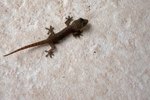
When you think of animals who live on the African savanna, mammals like elephants, zebras and lions probably come to mind. Indeed, they're well-known creatures of the wilderness; but many unique and beautiful amphibians and reptiles also make homes on the plains and grasslands of the African continent.
Snakes
Many snake varieties live on the African savanna. Some are poisonous, and some are dangerous by way of constriction. African rock pythons (Python sebae) are the largest and most temperamental snake in Africa.The snakes prefer moist, open areas near water sources. Though specimens average 15 feet, some may grow to almost 20 feet. Aggressive constrictors, rock pythons prey upon animals of all sizes -- from rats to antelopes. Other species of African snakes include the deadly black mamba (Dendroaspis polylepis), the southern brown (Dasypeltis inornata) and common (Dasypeltis scabra) egg-eaters, and multiple species of Adder.
Tortoises
Two types of tortoise are common across the African savanna. Leopard tortoises (Stigmochelys pardalis) can be found in drier, grassy locations. Though they require water, they do not need to live in it. Their shell pattern offers them camouflage in their natural habitat but also draws attention from poachers. At maturity, these tortoises can reach nearly 2 feet in length and weigh almost 100 pounds. The diet of these tortoises is almost all grasses and flowers and leaves, though some fruit is included. Sexual maturity arrives between 12 and 15 years of age. African helmeted turtles (Pelomedusa s. subrufa) are also common on the savanna. They live in ponds created by rainwater, burying themselves in the mud when the water dries up. These turtles grow to about 8 inches in diameter and feed on small fish, snails and other insects.
Frogs and Toads
African clawed frogs (Xenopus laevis) get their name from the large hind legs that have three claws at the end of each. Their slippery skin is typically olive-gray, brown, white or yellow. Like chameleons, they can change their skin color to better blend in with their surroundings. They reach lengths of 2.5 inches for males and 4.5 inches for females. Amietophrynus gutturalis, the African common toad, is widely found in grasslands, agricultural settings and towns. The toads have a variety of color patterns and average about 3.5 inches. African bullfrogs (Pyxicephalus adsperus) are large, measuring up to 9.5 inches and weighing over 4 pounds. Prey include insects, fish, other frogs, mice and even small birds. They live near water and use their strong back legs to dig holes in which to hide. African bullfrogs hibernate for many months, protected by a layer of mucus and mud.
Crocodiles
Crocodylus niloticus, Nile crocodiles, live in the African savanna. These sneaky predators are adept hunters who will consume nearly any meat imaginable. Capable of reaching 15 feet in length, these crocodiles prefer swampy locations close to large bodies of water, where they can easily hide themselves to stalk prey as well as to rest. Their only predators are humans, and they are not endangered. West African dwarf crocodiles can also be found in the grasslands. Much smaller than the Nile species, the dwarfs only grow to about 6 feet. Their size limits their food sources to smaller creatures like fish, which they swallow whole. They can live to be 100 years old and are identifiable by the knobs on the ends of their snouts and their brownish-green coloration.
Lizards
Though many varieties of lizard live in the savanna , the most recognizable include chameleons like Meller's chameleon (Chamaeleo melleri), the flap-necked chameleon (Chamaeleo dilepis) and Natal midlands dwarf chameleon (Bradypodion thamnobates). These species share characteristics like changing colors to blend into their surroundings, very fast tongues that allow them to capture their prey, and life spans of more than 12 years. They differ in size, ranging in length from only a few inches to more than 2 feet. Other lizards found on the savanna include geckos, skinks and rock monitors. Varanus albigularis, also called white-throated monitors, are large lizards who lives in tunnels and scavenges for prey. Though they eat many invertebrates, they also enjoy carrion and small animals. The varying dark and light colors of their bodies allow them to better blend into their surroundings, as does the layer of dirt and unshed skin that often covers them.
References
- Animal Diversity: Python sebae
- Empire of the Turtle: Pelomedusa subrufa
- African Tortoise: Leopard Tortoise
- The Big Zoo: African Bullfrog
- African Amphibians: Amietophrynus gutturalis
- Smithsonian National Zoological Park: African Clawed Frog
- Safari.com: Reptiles and Amphibians
- Blue Planet Biomes: Nile Crocodile
- Pittsburgh Zoo: West African Dwarf Crocodile
- Mpushini Wildlife: Reptiles
Photo Credits
-
Comstock/Comstock/Getty Images




